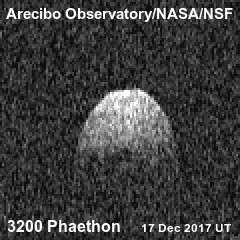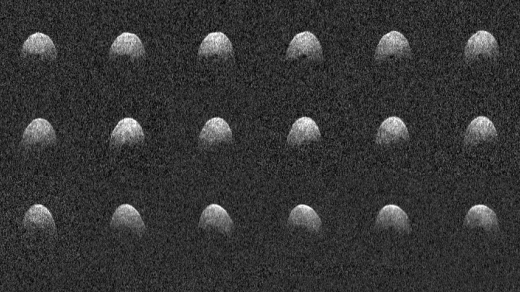
With the holidays behind us (alas), I want to be sure to cover the Arecibo observations of asteroid 3200 Phaethon, not only for their intrinsic interest but as a nod to the restoration of operations at the Puerto Rico observatory. We are fortunate indeed that the structural damage Arecibo suffered on September 20 because of hurricane Maria was relatively minor. Radio astronomy work was back in progress within days of the storm, though it took until early December before commercial power was restored and radar work could resume.
If you’re interested in radar astronomy, have a look at Alessondra Springmann’s How Radar Really Works: The Steps Involved Before Getting an Image, which is available via The Planetary Society. Springmann offers a detailed overview of radar operations with a splash of humor:
Arecibo Observatory is known for its 305-meter (1000-foot) diameter telescope and its appearances in Goldeneye and Contact. Aside from battling Bond villains and driving red diesel Jeeps around the telescope (grousing at the site director about the funding status of projects is optional), several hundred hours a year of telescope time at Arecibo go toward radar studies of asteroids. A group of four planetary radar astronomers at Arecibo (as well as collaborators and colleagues at institutions outside of Puerto Rico) is tasked with “finding them before they find us” by NASA’s Near-Earth Object Observation program. We study the orbits and surface properties of our rowdy neighbors, near-Earth asteroids.
‘Finding them before they find us’ indeed. Arecibo contains the most powerful radar system on the planet, making it a key asset for planetary defense, a great part of which is keeping an eye on asteroids close enough to be problematic. This is a facility we need to keep in action as we continue to build the catalog of near-Earth asteroids and examine their properties. The recently released observations of 3200 Phaethon were conducted from December 15 to 19, 2017.

Image: These radar images of near-Earth asteroid 3200 Phaethon were generated by astronomers at the National Science Foundation’s Arecibo Observatory on Dec. 17, 2017. Observations of Phaethon were conducted at Arecibo from Dec.15 through 19, 2017. At time of closest approach on Dec. 16 at 3 p.m. PST (6 p.m. EST, 11 p.m. UTC) the asteroid was about 10.3 million kilometers away, or about 27 times the distance from Earth to the moon. The encounter is the closest the object will come to Earth until 2093. Credit: Arecibo Observatory/NASA/NSF.
About Phaethon itself, we know that it is about 6 kilometers in diameter, larger than previously thought, and is the second largest near-Earth asteroid in the category classified as ‘potentially hazardous.’ Size and close approach are determinants of which asteroid fits into that category, but work on any passing asteroid is useful because radar can study its size, shape, rotation, and surface features, while adding to our knowledge of its trajectory. Joan Schmelz, Arecibo’s deputy director, calls the facility “crucial for planetary defense work,” and that it is.
The images of 3200 Phaethon are the best we’ve yet taken, showing a spheroidal object with a large concave depression near its equator and a dark circular feature near one of its poles. The resolution in these images is about 75 meters per pixel.
“These new observations of Phaethon show it may be similar in shape to asteroid Bennu, the target of NASA’s OSIRIS-REx spacecraft, but more than 1,000 Bennus could fit inside of Phaethon,” said Patrick Taylor, a Universities Space Research Association (USRA), Columbia, Maryland, scientist and group leader for Planetary Radar at Arecibo Observatory. “The dark feature could be a crater or some other topographic depression that did not reflect the radar beam back to Earth.”
This asteroid is, by the way, the first to be discovered through images taken from a spacecraft, the craft in question being the Infrared Astronomical Satellite (IRAS), which produced data that Simon Green (Open University) and John K. Davies (then at Leicester University) examined to find the object. It is the parent body of the Geminids meteor shower and, given over thirty years of observations, is an asteroid with a well determined orbit, one well constrained for the next 400 years. The closest approach to Earth in 2017 was known with an accuracy of ±40 kilometers.



I’m glad that Phaethon is *not* (so far) living up to its mythological namesake (and I also hope that the myth wasn’t inspired by some solar energy output “hiccup”–perhaps in far-ancient times–that made people fear that the Sun was ‘coming too close to the Earth’…). Phaethon, which ^appears^ to be tri-axial in the radar images, might be a good “ground truth” target for a solar sail test mission (as well as a scientifically interesting target in its own right), to correlate the radar-observed surface features with what a spacecraft camera would show, and:
I too had wondered what shape the Arecibo antenna was in after the hurricane. Having seen what Hurricane Andrew did to cable-guyed radio and television transmission towers (and even an enormous, self-supporting tower–WCIX Channel 6’s steel behemoth caused an earthquake when it fell down that night!) in south Florida, I feared the worst for Arecibo (whose reflector panels were–at least in the 1980s, when I saw a TV report about it–held in place just by their own weight; an observatory staff member simply picked up one or two of them to hold in front of the TV camera). Wind-induced vibrations could also have wrecked the suspended feed, although apparently it can be lowered if a hurricane strikes (see: http://en.wikipedia.org/wiki/Arecibo_Observatory [incidentally, this article says that you supported a “commemorative METI” transmission from Arecibo to two stars, the “RuBisCo Stars” message]). Luckily, only about 30 out of the 38,000 panels were damaged, by a falling antenna feed line. Also:
Planetary defense, radio astronomy, radar astronomy, SETI, and METI really are vulnerable, having just one telescope of this size in the Free World, and even Arecibo is financially threatened–the above-linked article says, in part:
“The damage sustained from Hurricane Maria in September 2017 is further clouding the observatory’s future. Although the damage was minimal,[12][13] restoring all the previous capabilities would require more than the observatory’s already-threatened operating budget, and users fear the decision will be made to decommission it instead.[65]”).
If Arecibo is closed, it will be a monumental act of shortsightedness.
One troubling addendum: Arecibo was even luckier than I’d thought; its cable-suspended feed apparently *cannot* be lowered before a hurricane hits, as its original (four-support) design–which is described in the Wikipedia article about the Arecibo Observatory (see: http://en.wikipedia.org/wiki/Arecibo_Observatory )–had provision for, and:
This article in “Science” (see: http://www.sciencemag.org/news/2017/09/hurricane-damage-threatens-arecibo-observatory-s-future ) describes the observatory staff’s storm preparations, and they didn’t lower its suspended feed; also, the following quotation from the article is particularly disheartening:
“But many are worried that the damage, likely on the scale of millions of dollars and apt to keep the observatory closed for weeks or months, will further threaten the existence of Arecibo, which is already on a short list of facilities facing possible closure or downsizing by the National Science Foundation (NSF) in Alexandria, Virginia. ‘I fear that if there is significant damage, that will provide the decision point to decommission the observatory,’ says space scientist John Mathews of Pennsylvania State University in State College.”
Could someone explain to this non-scientist (but amateur radio licensee, with a wee bit of knowledge about radio) the apparent bright parts of the returned image? I understand that the asteroid is ‘lit’ by radar, not light; why then is the returned image bereft of data (towards the bottom)?
Indeed the data appears to fall of rather smartly down the image?
Read the Springmann reference Paul linked to in the article.
Finding them before they find us? A worthy goal, but AFAIK planetary radar has not found a single asteroid, nor would I expect it to – small beam sizes and the 1/R^4 decay of returned power with distance make this very unlikely. Radar doesn’t find asteroids, but it does a great job of finding out what they are like.
University of Central Florida is taking charge of gigantic Arecibo radio telescope
By Alan Boyle
February 22, 2018 at 12:49 pm
The famous 1,000-foot Arecibo radio telescope in Puerto Rico will be under new management, led by the University of Central Florida.
Full article here:
https://www.geekwire.com/2018/university-central-florida-taking-charge-gigantic-radio-telescope-arecibo/
To quote:
The management plan calls for upgrading the capabilities of the telescope — which spends a lot more time tracking asteroids, pulsars, fast radio bursts (and the occasional weird signal) than it does looking for alien messages [pity]. Ray Lugo, head of UCF’s Florida Space Institute, told Science that the consortium hopes to attract more business related to such applications as asteroid mining and military sensor testing.
Outside the science community, Arecibo is perhaps best-known as the place where Jodie Foster’s character began her search for extraterrestrial intelligence, or where James Bond (played by Pierce Brosnan) dodged death in the climactic scene of “Goldeneye.”
Last year, Arecibo went through a real-world, life-and-death drama when it suffered Hurricane Maria’s blows. The facility sustained significant damage, but fortunately, the observatory’s staff members were unharmed and able to help out with relief efforts.
For most of its 55-year history, Arecibo reigned as the world’s largest single-dish radio telescope — but that title was passed on to China’s Five-Hundred-Meter Aperture Spherical Telescope, or FAST, in 2016 [which will be conducting SETI as one of its official scientific goals].
Arecibo may be back at work, but it still has problems thanks to Hurricane Maria:
https://www.wired.com/story/puerto-ricos-observatory-is-still-recovering-from-hurricane-maria/?CNDID=43322468&mbid=nl_061618_daily_list1_p4